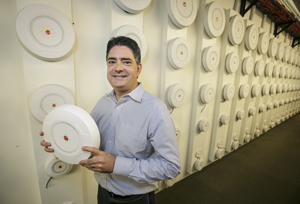With the number of smartphone subscriptions forecast to more than double in the next five years, Xirrus Inc. has products to keep those devices connected. The Thousand Oaks company designs and manufactures Wi-Fi connections for large venues such as colleges, convention centers, hotels, corporate offices and hospitals. All told, said Bruce Miller, vice president of product marketing, the company has installed about 10,000 Wi-Fi access points – round devices mounted on the ceiling that resemble a smoke detector – for its customers. Xirrus finds itself at the forefront of the emerging Internet of Things, defined as networks in which devices in addition to people communicate with each other. The trend presents a huge opportunity for the company. “It is in the sensors in your car for tire pressure, it is in watches, in your thermostats and not just your smartphones, laptops and tablets,” Miller said. Few companies provide the same service as Xirrus, but some of its rivals are much larger – and sport household names. The main competitors are San Jose’s Cisco Systems Inc. and Palo Alto’s Aruba Networks Inc., which was acquired early this year by Hewlett-Packard Co. To face those behemoths, Xirrus has separated itself with Wi-Fi access points that have a low price point and are easily adaptable as technology changes. Also, it makes software that allows system management by showing the number of devices logged in and the number and type of applications each is using. “If you have thousands of people on your network, you have to have it working,” Miller said. “If it’s not, the red lights go on and you can see what the problem is.” Price points New Xirrus products announced in recent weeks include the X-2, a transmitter-receiver with up-to-date technology at a cost the company says is 30 percent less than the competition, and an access point using multiple radios to communicate with up to four devices simultaneously. The company achieves adaptability by making equipment from modular components, so it’s easy to snap new parts into place when they become available. The software that coordinates the access points can be reprogrammed to adapt to new devices and faster connection speeds as technology progresses. Xirrus prices its hardware starting at $395 to more than $1,000 per access-point device. Miller said customers often pay less than those amounts because they buy dozens or hundreds at a time. It doesn’t take long for the costs to add up. “A million-dollar deal is not uncommon when you get into schools or large venues,” he said. Also, competitors have a pecking order in their product line, so the newest equipment is more expensive while the oldest is cheaper. In contrast, Xirrus tries to counter that with innovation. It recently started selling an access point that communicates with up to four devices simultaneously by employing four connectors in a single radio. Miller compared this new device to adding lanes to a freeway, because standard access points communicate with one device at a time. With more channels, customers can buy fewer access points. That appeals to IT managers as a long-term investment because not many Wi-Fi hardware suppliers offer the faster connections right now, Miller said. “We’re giving you the full enchilada,” he added. “You don’t have to wait for it and you’re not going to pay extra for it.” Expanding market Market forecasts suggest that Xirrus could be well-positioned for the next stage of wireless growth. Communication technology provider Ericsson, in Stockholm, forecasts that subscriptions for smartphones will increase to 6.1 billion by 2020 from 2.6 billion last year. Amy Storey, vice president of public affairs at CTIA – the Wireless Association, a Washington, D.C., advocacy group, said that as mobile devices and Wi-Fi networks improve, it will enable uses beyond just phone calls, Web browsing and email reading. Already, Wi-Fi allows for tracking packages and is used in municipal water systems for leak detection. “Before an issue occurs they can identify the spot and fix it,” she said. While Xirrus hardware is found in hospitals such as Harbor-UCLA Medical Center and in convention centers, its primary market is high school and college campuses. Fueling that is the E-Rate program administered by the Federal Communications Commission that includes funding for wireless communications in schools. The budget for the program is $3.9 billion. Searl Tate is director of networks and engineering at Paul Hastings, a global law firm based in Los Angeles that has been a customer of Xirrus for about six years. What jumped out at him about the company was its array of access points that could cover large conference rooms and handle the rising number of devices. “There is a certain agility with a smaller company that is different than a big company that stands on its own,” Tate said. Xirrus employs more than 100 people, mostly in its Conejo Valley headquarters, but also has offices in Silicon Valley and Reading, U.K. The company would not disclose its revenue. Xirrus was started in 2005 by co-founders Dirk Gates, its executive chairman; Steve DeGennaro, chief financial officer; and Chief Development Officer Patrick Parker. The three previously worked together at Thousand Oaks’ Xircom Inc., which Gates founded in 1988 and sold in 2001 to Intel Corp. for more than $700 million. Xircom produced network-connectivity products using wires, and for his follow-up company, Gates decided to eliminate wires altogether. Wi-Fi was starting to emerge in the early 2000s, and while private equity money was flowing toward the device makers, it was not the same for wireless networks. “There was nobody speaking to the infrastructure side,” Miller said. “All of these devices have to connect to an access point.” Eventually, Xirrus received funding from private equity groups August Capital Management, Canaan Partners and InterWest Partners. In March, the company raised $6.8 million as part of an investment round intended to gather $13.8 million, according to a filing with the Securities and Exchange Commission.
